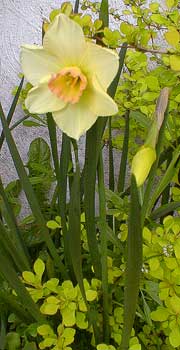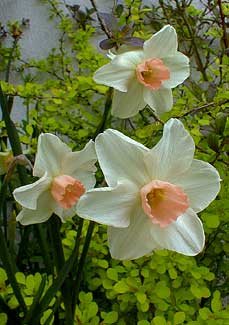
'Bell Song' Small Jonquil
or Miniature Daffodil
"Bread is food for the body.
Narcissus is food of the soul."
-Mohammed
Narcissus jonquilla 'Bell Song' was developed in the United States by the late Grant E. Mitsch, & introduced to gardening in 1971. It grows to one foot or fifteen inches tall, producing an exceptionally elegant flower with creamy palest yellow (amost ivory) petals, & a pink-fringed trumpet.
Jonquil cultivars are the most sweetly scented of daffodils. They are also "floriferous" or "cluster-flowering," which is to say each stalk typically produces more than one flower, two easily, sometimes as many as six. They perennialize with great ease becoming increasingly floriferous with each year.
Jonquil bulbs are planted four inches deep in autumn. Most jonquils like a very sunny location, but also do well in partial shade. However, salmon to pink-trumpet varieties like 'Bell Song' require a bit of protection & would in the main prefer dappled sunlight, or their rare color rapidly fades.
 They can be given a high-potash fertilizer after blooming, or not. The leaves should not be cut back until they begin to yellow & brown, so that the bulb will be strengthened for the following year.
They can be given a high-potash fertilizer after blooming, or not. The leaves should not be cut back until they begin to yellow & brown, so that the bulb will be strengthened for the following year. They're more heat-tolerant than the majority of daffodils & can be grown further south (to USDA Zone 9 & for some varieties Zone 10). In warmer climates it may be best to give all jonquils dappled shade & not over-sun them. For all their heat tolerance, they're no less cold-hardy than other narcissi, requiring mulch over the dormant bulbs only when grown further north (to Zone 5).
Mulching is not required on Puget Sound, since our gardens are never terribly frozen in winter. But if there is any threat of soils being too wet during dormancy, a covering of mulch of large maple leaves or fern fronds gathered from elsewhere in the garden will help barrier the ground from too much rainfall. In spring of course they welcome moist soil, though in our climate late winter & early spring rainfall is sufficient.
When ours first start blooming in April (2003), the surrounding deciduous shrubbery permitted them sufficient light as they were not yet completely re-leafed. But since small jonquils bloom until June, they were quite deeply shaded by the end of their cycle, so our choice of location was not the best planned.
We hadn't foreseen just how big some of the shrubs would be in full leaf. In these April photographs of 'Bell Song' you can see the golden leaves of a Golden Barberry which stays small enough that it does not greatly shade the jonquils. But to the left & above, just outside of these pictures, there's a vastly larger Red Barberry which became increasingly tall & bushy as spring progressed, so that eventually the jonquils were completely hidden.
We select varieties of daffodils that certainly perennialize & often naturalize. But they will not do so if lingering leaves don't get enough sun later in spring, in order to recharge their bulbs for another spring. In the future I won't plant daffodils in this area underneath the barberry bushes & the Western Syringa, as when releafed they don't permit the jonquils enough sunlight to fully establish.
Despite that these bloomed excellently their first spring after their autumn planting, the location was bound to weaken them for future springs. I considered lifting them as soon as the leaves were dying back, but as jonquils can stand a bit more shade than large hybrid narcissi, I tried to convince myself they'd be fine where they were at. Through the rest of the year, though, the area became increasingly overgrown, so I sifted through the soil in October, & moved the 'Bell Song' to a sunnier garden, near clumps of Echinacea. The bulbs felt depleted & some had rotted, so how well the remainder will recover for this coming spring is something we'll just have to wait & see.